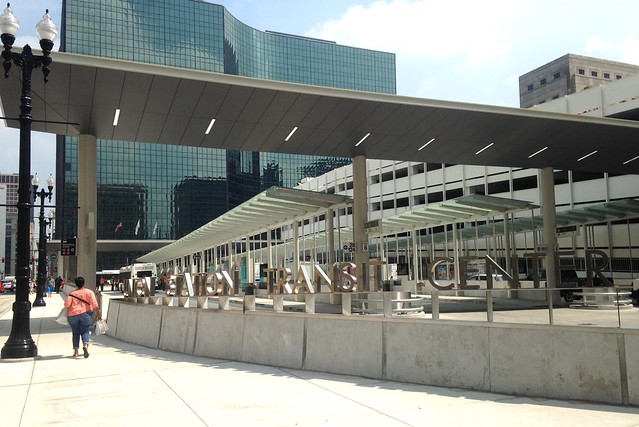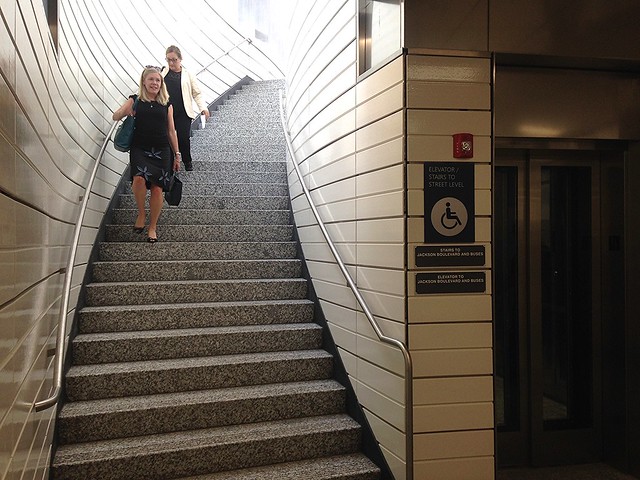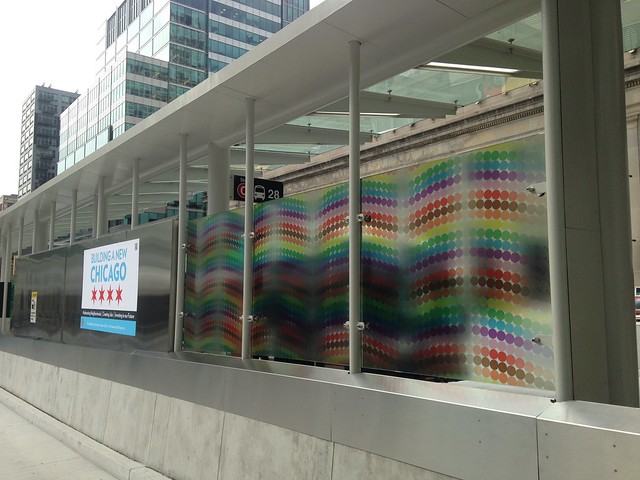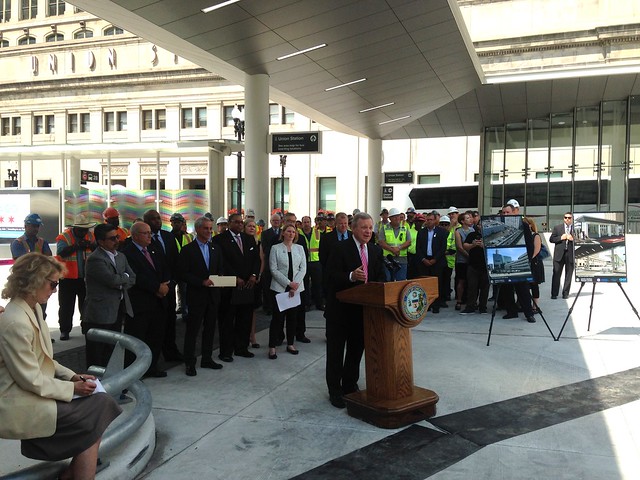This afternoon officials cut the ribbon on the Union Station Transit Center, a new facility across the street from the Amtrak and Metra hub that will make it easier to make transfers and will better organize West Loop traffic. The transit center opens to the public this Sunday. It’s the latest step in the development of the Loop Link bus rapid transit route, which debuted on Washington and Madison Streets last December.
The USTC is located just south of the train station, at Jackson Boulevard and Canal Street, on land formerly occupied by a surface parking lot, which the city acquired by eminent domain. The following bus routes will use the transit center:
- #1 Bronzeville/Union (Will stop at Jackson)
- # 28 Stony Island
- #121 Union/Streeterville Express (Will stop at Jackson)
- #124 Navy Pier
- #151 Sheridan
- #156 LaSalle
The transit center itself consists of bus boarding areas with weather protection, seats, Ventra machines, and bus tracker displays. Like much of the transit infrastructure the city builds nowadays (see the Loop Link stations and the upcoming Washington-Wabash ‘L’ station), the skeletal forms of the USTC shelters seem inspired by the work of Spanish architect Santiago Calatrava.
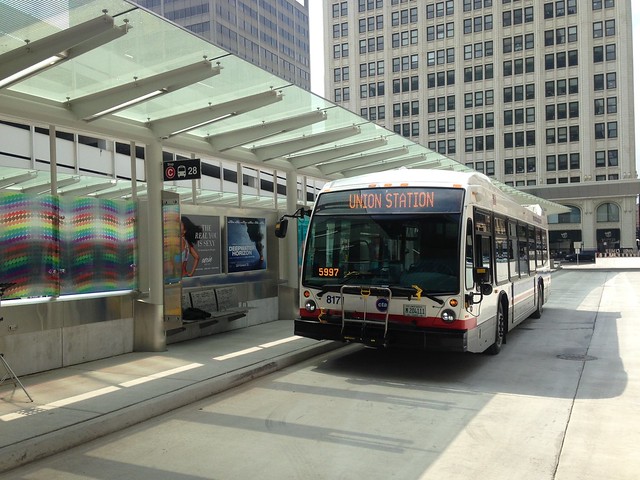
And, annoyingly, like the Loop Link shelters, the backs of the USTC shelters stop several feet before the canopies. That means, as with the Loop Link facilities, they will provide less weather protection than a standard CTA bus shelter and the seats will get wet in heavy rain. It would be great if the city could figure out way to deter long-term loitering in facilities like these while still allowing the shelters to serve their intended purpose – keeping commuters dry while they wait for buses.
On the plus side, the USTC will allow for relatively seamless transitions between CTA buses and Amtrak and Metra trains. Instead of having to cross a street to get to Union Station, riders can takes a new staircase or elevator to and from the bus station. Unfortunately, unlike many CTA stations, there’s no escalator option.
Meanwhile, the Chicago Department of Transportation is reconfiguring Canal Street between Jackson and Adams Street to make it function better as part of Loop Link. The east side of Canal between Jackson and Adams, on the east side of Union Station, is now reserved for bus and wheelchair vehicle pick-up and drop-off only, while the west side is for all other through traffic including taxi and passenger car pick-up-and drop-off. CDOT has also added a pedestrian island and mid-block crossing on Canal. There will also be a dedicated traffic light for buses exiting the USTC.
The old northbound conventional bike lane on Canal was removed as part of the project and replaced by a two-way protected bike lane one block west on Clinton Street. While the PBL currently goes no further south than Jackson, it will soon be extended three more blocks to meet up with protected bike lanes on Harrison Street.
At this afternoon’s event, CDOT commissioner Rebekah Scheinfeld argued that the transit center will benefit all travelers, not just transit users. “By creating this off-street space for CTA buses to load and unload passengers, and layovers between runs, the USTC will also improve traffic flow around Union Station by removing buses [from surrounding streets].”
CTA president Dorval Carter, Jr. praised the artwork created for the shelters by local artist and educator James Jankowiak – waves of rainbow-colored dots on the glass back panels – which Carter called “vibrant and invigorating.” Carter said the design is supposed to symbolize the movements of Chicago’s color-coded transit lines.
Mayor Rahm Emanuel said the USTC is part of efforts to optimize the potential of Union Station, which he said currently “fights below its weight class,” although it handles some 120,000 passengers a day, significantly more than Midway Airport. “This investment is part of our effort to make Union Station a real economic engine,” he said.
U.S. Senator Dick Durbin, who helped secure the $30 million in federal funds used for the $41 million project, took a moment to thank President Obama, who has only a few months left in office, for supporting funding for initiatives like this. “It’s been a blessing for us as a state and the city of Chicago to have someone in the White House who understands this city, this region, and this state.”
Durbin joked that he preferred not to refer to the USTC as an “intermodal” facility, a word he said lacks romance. “I don’t know who made up that word, but it had to be someone sitting at a desk who never rode on a train like the California Zephyr,” he said. "I don’t use that word in polite company. What we have here is a transit center across the street from a 2oth Century palace of transportation.”
Durbin noted that the job of the Union Station Master Plan is to bring the facility into the 21st Century. As part of the plan, earlier this summer the engineering firm Arup began the next phase of planning, historic review and preliminary engineering for the restoration and renovation of the station. The design work includes expanded concourses and entrances, widening of platforms, ADA compliance, pedestrian passageways and issues related to ventilation.
Recently the upscale Legacy Club and Metropolitan Lounge opened at the station, air conditioning was added to the Great Hall, and the hall’s staircases, made famous in the movie “The Untouchables,” were refurbished. Amtrak is currently conducting a request for proposal process to select a “master developer” to lead the full implementation of the master plan, including redeveloping the Amtrak-owned station and surrounding land parcels, as well as making improvements to passenger and employee facilities.
While the Union Station Transit Center, as well as the Loop Link corridors on Washington and Madison, represent progress in terms of transit infrastructure, Loop Link still isn’t living up to its full potential in terms of improved bus speeds. One major issue is the frequent use of the red bus-only lanes by unauthorized vehicles such as shuttle buses, delivery vehicles, taxis, and private cars, as highlighted by the #NotaCTABus Twitter campaign.
@AriesCharter 13611 blocking the bus and bike lane on washington @ChicagoDOT @ChicagoBACP #NotaCTABus #enforce940060 pic.twitter.com/2yyL8meTew
— Jett (@CJettR) August 30, 2016
Following the ribbon cutting, CDOT’s Scheinfeld acknowledged the problem but said she believes the situation is improving as all road users get used to the street layout. She suggested that citizens intervene if they see a violation. “If you see someone that’s not following the rules of the road there, gently remind them and help make people aware… ‘Hey, this is a bus lane.’”
“When I’m walking down the corridor and I see people who are not aware, like a truck driver idling in the wrong place, I have a conversation with that person and make sure they’re aware of their options, especially if it’s someone making a regular delivery,” Scheinfeld said.
Shuttle bus lines, whose vehicles frequently appear in #NotaCTA Bus tweets, are some of the worst Loop Link offenders. Scheinfeld said these companies have been notified that it’s illegal for their buses to use the red lanes and police do sometimes ticket their drivers. “Certainly [shuttle bus violations] happen, but I wouldn’t call it a standard practice,” she said.
The commissioner didn’t say whether the city is considering introducing camera enforcement of the bus lanes, which has been effective in cities like New York. “Certainly some folks have suggested that,” she acknowledged. “But that’s something that would require state legislation.”
If Loop Link scofflaws continue to be a frequent problem, hopefully the city will take a serious look at camera enforcement of the lanes.
